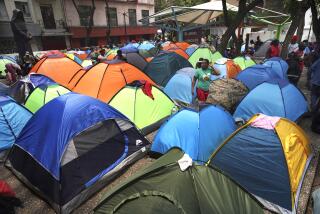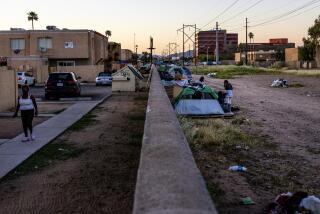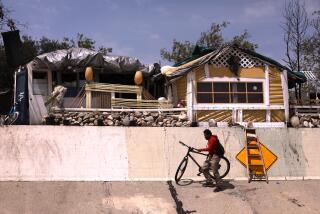Tent Dwellers Pressure Government : Mexico Quake Victims Still Out in Cold
MEXICO CITY — In the Plaza of the Three Cultures, where architectural monuments from the Aztec era, the colonial era and modern Mexico stand side by side, a ragged tent city of homeless people has taken root since the devastating earthquakes of last September.
Four months have passed since back-to-back earthquakes destroyed these people’s homes, but they have yet to find any permanent shelter. And while they wait, they have had to contend with unusually cold weather and a lack of sanitary services.
Some of these people have refused to move to more secure shelters, even though they could have done so. Their presence here brings pressure on the government, and they do not fully trust the government as it goes about the slow process of resettlement.
“We could become the fourth culture in the plaza,” Felipe Vasquez, a factory worker, quipped the other day. “We won’t leave until we are assured of getting homes.”
The homeless people of the plaza make up just one of the collections of quake victims scattered across Mexico City. Government officials estimate that there are 12,000 of them, some living on street corners and in parks and vacant lots. Thousands of others have found refuge with relatives and in government shelters.
Their wait for new housing is expected to be a long one. No buildings are going up for the homeless, though the government has considerable resources available and has expropriated land for this purpose.
Construction has been held up by bureaucratic checks on who is eligible for housing aid. Not until last month did the city begin issuing certificates that entitle the homeless to new housing.
Officials at several government shelters report a recent sharp rise in the number of people seeking refuge, and they suspect that many of the new arrivals are not quake victims at all but people trying to escape from substandard housing. There are millions of people in this category.
“Many of them,” Jorge Contreras, a city social worker said, “are people who hope to get housing along with those who lost their homes in the September earthquakes.”
In all, the government expects to put up apartments for more than 44,000 families. Some of the units will be sold and others will be rented to people driven from their homes by the earthquakes.
The plight of the homeless has been aggravated by uncharacteristically cold winter weather. In early January, temperatures dipped to a record 27 degrees Fahrenheit. Twenty people were found dead in the streets, although it was not clear that these were people who had been left homeless by the earthquakes.
Legions of Destitute
For years, Mexico City has had legions of destitute, homeless people, and when it turned cold, many of them huddled in dangerously damaged buildings seeking warmth.
During the most recent cold spell, laundry left out to dry at the outdoor shelters froze stiff overnight. Many children awoke with chest colds.
“I don’t know how much more we can stand, but we have no choice,” Vasquez, the factory worker, said.
His family, including his wife and mother, is living in a blue tent in the Plaza of the Three Cultures, along with 50 other families. Their shelters are spread among the Indian pyramid, the 16th-Century Spanish church and the block-style apartment buildings that characterize the plaza.
Like the other displaced people, the Vasquez family relies on portable toilets and public baths. They cook on small stoves in the open air.
The Vasquez family faces a special resettlement problem. Although the family lived in one of the plaza apartment blocks that were damaged in the quake, it had sublet from another tenant. This is a common practice in housing-short Mexico City, but it means that the Vasquez family has no receipts to show as proof that it lived here and is thus entitled to government help.
Rent Money Problem
Moreover, the Vasquezes are not sure that they can pay the rent in a new place. They paid the equivalent of $15 a month before, and new housing would probably cost $50 a month, the Vasquezes have been told.
While they are haggling over this with the authorities, the Vasquezes refuse to move from their tent into a government shelter nearby.
“We have to keep our feet here so the government does not forget us,” Vasquez said.
Some people who were driven from their homes at the plaza have moved into metal sheds that the government put up behind a Coca-Cola bottling plant about a mile away. The sheds are roomier than the tents and furnish better protection against the cold. They have electricity and running water.
But this comparative comfort has not eased the uncertainty. Loreta Martinez, an elderly street vendor, had a fairly spacious apartment in the Tlatelolco housing complex, and she fears that the government intends to provide her with a smaller unit in a distant neighborhood.
“Then they can repair my old building and sell it for a profit,” she said.
Like many of the displaced, Martinez has joined a tenants’ group that is negotiating with the government.
Satisfaction Wanted
“It makes me tired,” she said, “but even if I have to wait 10 years, I want satisfaction.”
In the working-class neighborhood of Tepito, residents forced from their homes by the earthquakes have organized a series of squatter colonies, rigging their own electrical power lines and using scrap siding for walls.
“We are accustomed to doing things by ourselves,” said Evangelina Perez, one of a group of 29 families from a tenement who have settled on a busy street corner in Tepito. The land where Perez’s building stood has been expropriated by the government and officials have promised to rebuild housing there. Her main worry is that the government intends to build smaller units to accommodate a greater number of tenants.
“We’ll be watching closely,” she said. “Before, we each lived in 150 square feet. We don’t want any less now.”
In the meantime, Perez and other homeless people are preparing for a long haul by lining their apartments with Christmas wrapping paper to keep out the cold. They have been told that their new homes will not be ready for at least a year.
More to Read
Sign up for Essential California
The most important California stories and recommendations in your inbox every morning.
You may occasionally receive promotional content from the Los Angeles Times.










